= Portulacaria afra f. variegata
10: 81 1955.
Accepted Scientific Name: Portulacaria afra
Collectanea [Jacquin]
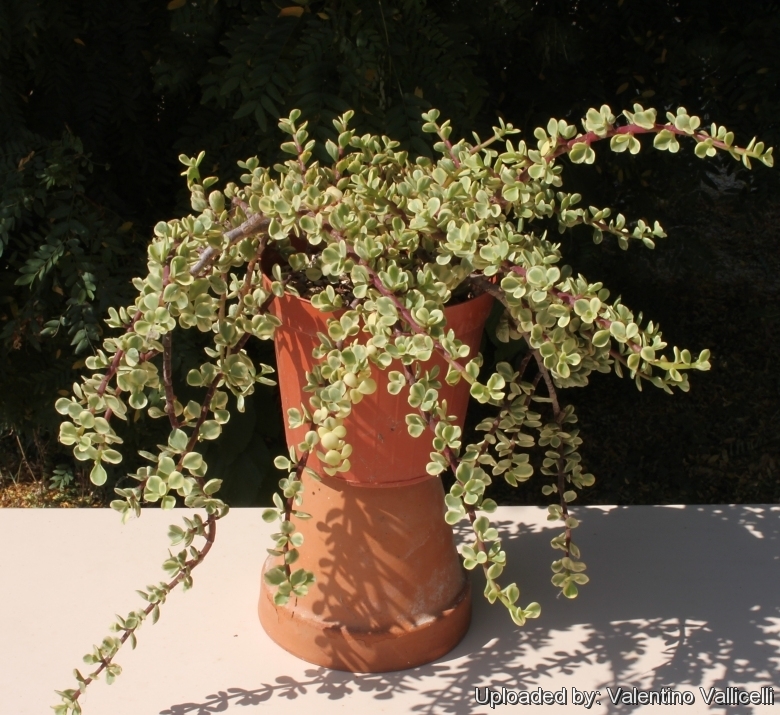
Portulacaria afra f. foliis flavo-variegatis (Portulacaria afra f. variegata) Photo by: Valentino Vallicelli
Origin and Habitat: Garden origin.
Synonyms:
See all synonyms of Portulacaria afra
back
Accepted name in llifle Database:Portulacaria afra Jacq.Collectanea [Jacquin]Synonymy: 6
back
Common Names include:
ENGLISH: Rainbow bush, Variegated mini jade plant
Description: Portulacaria afra f. variegata (Rainbow Bush) is a popular and highly adaptable variegated form with creamy-yellow mottled leaves. It looks rather like a small jade plant with nearly horizontally branches that sprawl on the soil. It is sometimes confused with Crassula ovataSN|18609]]SN|18609]] (Jade plant) because the plants look alike, but portulacaria leaves are smaller and the stems are wiry. Cascading carefully pruned Portulacaria afra f. variegata resemble living sculpture when displayed on a pedestal. Tiny pink flowers appear in summer.
Habit: It is a small prostrate or pendant succulent shrub with yellow-variegated leaves that seldom grows over 20 cm high.
Stem: Jointed. Main stem(s) green when young, latter becoming mahogany-colored with prominent leaf scars. Bark reddish-tinged.
Leaves: Evergreen or deciduous, opposite, pink, silky smooth, cream and lime green broadly elliptic to rounded (20-30 x 11-18 mm), thick and fleshy with a sharp point, margin entire. Each leaf set directly into the reddish stem or into short spurlike branches, petiole absent.
Flowers: Up to 2 mm in diameter, pale pink to purplish, produced in small many-flowered clusters at the ends of branches, pink. Sepals 2, persistent. Petals 5, pink, persistent.
Blooming season: When drought stressed and given full sun, portulacaria produces sprays of tiny purple blooms. Mostly from spring to summer.
Fruit: Small narrowly 3-winged capsule ± 5 mm long, indehiscent,1-seeded.
Subspecies, varieties, forms and cultivars of plants belonging to the Portulacaria afra group
Bibliography: Major references and further lectures
1) Stuart Max Walters “The European Garden Flora: Dicotyledons” (Part I) Cambridge University Press, 1989
2) Debra Lee Baldwin “Succulent Container Gardens: Design Eye-Catching Displays with 350 Easy-Care Plants“ Timber Press, 20/gen/2010
3) Ernst Schmidt, Mervyn Lotter, Warren McCleland “Trees and Shrubs of Mpumalanga and Kruger National Park” Jacana Media, 01/gen/2002
4) Kristo Pienaar “The South African what Flower is That?” Struik, 2000
5) Portulacaria afra in: Journal of the Cactus & Succulent Society (US) 45(2): 71 (1973).
6) Braam Van Wyk, Piet Van Wyk “How to Identify Trees in Southern Africa” Struik, 01/gen/2007
7) “African Trees: A Photographic Exploration” Juta and Company Ltd, 2004
8) Ray Rogers “Crazy about Cacti and Succulents” Brooklyn Botanic Garden, 2006
9) Edgar Lamb “The illustrated reference on cacti and other succulents” Blandford Press, 1978
10) Barbara Segall "Botanica: the illustrated A-Z of over 10,000 garden plants and how to cultivate them" Mynah, 1997
11) Forest & Kim Starr “Portulacaria afra (Miniature jade plant, purslane tree)”. Plants of Hawaii. <http://www.starrenvironmental.com>. 23 Nov. 2014.
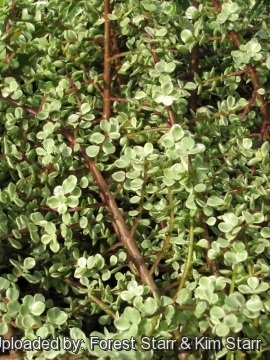 Habit at KiHana Nursery Kihei, Maui, Hawaii (USA). February 15, 2011. (Portulacaria afra f. variegata) Photo by: Forest Starr & Kim Starr
Habit at KiHana Nursery Kihei, Maui, Hawaii (USA). February 15, 2011. (Portulacaria afra f. variegata) Photo by: Forest Starr & Kim Starr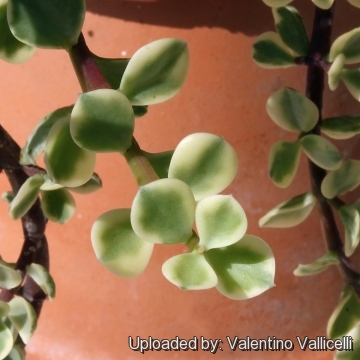 Portulacaria afra f. foliis flavo-variegatis (Portulacaria afra f. variegata) Photo by: Valentino Vallicelli
Portulacaria afra f. foliis flavo-variegatis (Portulacaria afra f. variegata) Photo by: Valentino Vallicelli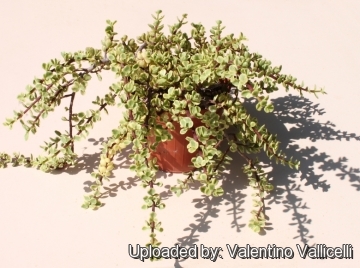 Portulacaria afra f. foliis flavo-variegatis (Portulacaria afra f. variegata) Photo by: Valentino Vallicelli
Portulacaria afra f. foliis flavo-variegatis (Portulacaria afra f. variegata) Photo by: Valentino Vallicelli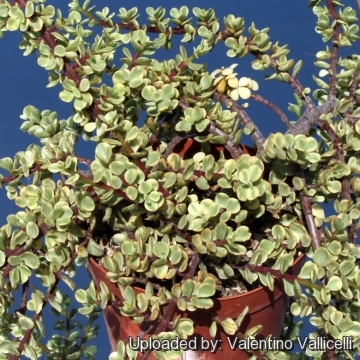 Portulacaria afra f. foliis flavo-variegatis (Portulacaria afra f. variegata) Photo by: Valentino Vallicelli
Portulacaria afra f. foliis flavo-variegatis (Portulacaria afra f. variegata) Photo by: Valentino Vallicelli Portulacaria afra f. foliis flavo-variegatis (Portulacaria afra f. variegata) Photo by: Valentino Vallicelli
Portulacaria afra f. foliis flavo-variegatis (Portulacaria afra f. variegata) Photo by: Valentino VallicelliSend a photo of this plant.The gallery now contains thousands of pictures, however it is possible to do even more. We are, of course, seeking photos of species not yet shown in the gallery but not only that, we are also looking for better pictures than those already present.
Read More... Cultivation and Propagation: Portulacaria afraSN|18165]]SN|18165]] f. variegata is a sturdy, adaptable, long lived small pot plant, it may be grown anywhere there is strong light. Exposure to fluctuating temperatures and arid atmosphere do not appear to affect its growth. It can be overwintered outdoors if sheltered from frosts.
Growth rate: Slow to moderate growth rate.
Soil: It adapts to most soil types, preferably not too heavy in texture; good drainage is desirable.
Repotting: Repot in the spring, when their roots become cramped. Generally, they should be repotted every other year in order to provide fresh soil. After repotting, do not water for a week or more. Needs a large pot to accommodate a large root system.
Waterings: It is extremely drought tolerant; A deep soaking once a month in the summer will keep the plant looking good. For pot culture in summer, during the vegetative period, it must be regularly watered, but allowing the substratum to completely dry up before irrigating again (but do not overwater ); in winter, it’s to be kept dry. Preferable not to water on overcast days, humid days or cold winter days.
Fertilization: Low food needs.
Exposure: A location with full sun or partial shade.
Pest and diseases: Overwatering and poor drainage will damage or kill the plant.
Uses: It is suitable for small “desert” gardens, in association with other xerophytes. The plant's form and texture are compatible with other succulents and cacti. Where the open air cultivation is not possible due to the climate, it is to be cultivated in pot in order to shelter it in winter.
Bonsai couture: Plants are tough and malleable, easily handle drastic pruning, and make good bonsai subjects.
Propagation: It is easily propagated by cuttings.















